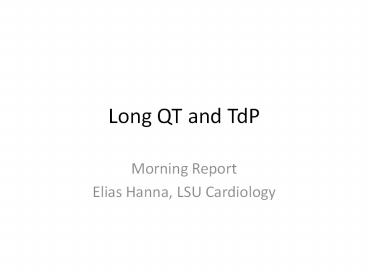Long QT and TdP PowerPoint PPT Presentation
Title: Long QT and TdP
1
Long QT and TdP
- Morning Report
- Elias Hanna, LSU Cardiology
2
(No Transcript)
3
- Markedly prolonged QT (QTc700 ms)
- Wide and ample T waves in V2-V4, deep T wave
inversion in the inferior leads - T wave alternans
4
Arrows of different colors point to the T wave
of alternating morphology every other beat,
called T wave alternans. T wave alternans may be
seen in a subgroup of patients with prolonged QT
and implies a very heterogeneous repolarization
and a more imminent risk of TdP. More typically
seen in congenital long QT syndrome
5
How to we define long QT?
- QTgt ½ RR
- Corrected QT (QTc)gt450 ms in M, 460 ms in F
6
How to calculate corrected QT?
- Corrected QT means QT corrected for heart rate.
QT normally decreases at faster heart rate. Thus,
while QT is normally lt460 ms at a rate of 60
bpm, a lower cutoff should be used for a rate of
100 bpm - How to calculate corrected QT
- 1-QTc QT/vRR ( RR in sec, not msec!!)
- e.g QT of 400 msec at a heart rate of 100
bpm - -At a rate of 100 bpm, RR interval is 600
msec0.6 sec? QTc400/v0.6515 msec
7
- 2-Another quick method QTc is the patients QT
had the heart rate been 60 bpm. Normally, QT ? 20
ms for every 10 beat ? in rate, and
? 20 ms for every 10 beat ? in rate - ? to calculate QTc, i.e QT at the rate of 60
for this pt, add 20 ms for every 10 beats above
60 - ? if QT is 400 ms at a rate of 100, then QTc
400 (4x20)480 ms - (the 2 methods may yield slightly different
results)
8
Differential dx of long QT
- Electrolytes (?K, ?Mg, ? Ca) (other
hypothyroidism) - Drugs (antiarrhythmics class I, III macrolide or
quinolone antibiotics antipsychotics) - Ischemia
- Congenital long QT syndrome (LQT 1,2,3)
9
In this case
- The pt had low K (3.0) and Mg (0.7).
- However, the shape of ST segment and T wave,
particularly the fact that T wave is wide and
ample T, does not fit with hypokalemia or
hypocalcemia (see next slide for electrolyte
shapes) - In light of the ST/T shape, K and Mg
abnormalities are not the sole cause of QT
prolongation but rather an exacerbating factor - The pt likely has ischemia or congenital long QT
syndrome as underlying etiology. - In this case, coronary angio did not show
any CAD, and QT interval strikingly ? but
remained prolonged (480 msec) after correction of
lytes abnormlities? congenital long QT syndrome
is the underlying cause of his QT prolongation
10
Typical ST/T shape in hypokalemia
ST depression with prominent T (actually U) and
prolonged QT when Klt2.5-3
Flat T with K3
11
Hypocalcemia Long QT that is due to a long ST
segment, which is different from long QT due to
congenital long QT syndrome, drugs, or
hypokalemia. T wave is not wide, there is no T
wave abnormality.
12
Hyperkalemia
13
- The ST/T shape in this case is not typical of
electrolyte abnormalities, but QT prolongation is
certainly exacerbated by these electrolyte
abnormalities
14
Pt goes into this rhythm
Torsades de pointe (polymorphic VT with changing
QRS polarity,
with a long baseline QTc)
sinus
VF (disorganized and chaotic rhythm, QRS almost
vanishes every now and then)
Defibrillation
15
Polymorphic VT vs. TdP
- Polymorphic VT with changing polarity of the QRS
complexes is not necessarily torsades de point
(TdP). - In order to say TdP, you need to have
- (1)polymorphic VT as in the prior slide
- (2) long baseline QT on the ECG obtained
before or after TdP - If you have TdP but normal QT, then the rhythm is
called polymorphic VT not TdP - The tx of TdP is different from polymorphic VT
16
- Polymorphic VT is usually an ischemic rhythm and
is treated with shock, emergent cath/PCI, and
amiodarone
17
- TdP is given 3 therapies
- 1-Defibrillation
- 2-Magnesium 2 g IV (regardless of Mg level)
start correcting K - 3-Temporary pacing after the run of TdP has
resolved. Temporary pacing prevents TdP from
recurring - Usually, TdP occurs in a pt with prolonged
QT who is also bradycardic. Bradycardia further
prolongs QT and furthers disperses repolarization
delays across the myocardium. Bradycardia is a
major trigger of TdP, particularly TdP in
patients with acquired long QT. Pacing to a rate
of 80-100 bpm will prevent TdP recurrence. - Pacing does not apply to our pt here
because he is tachycardic. Congenital long QT, as
opposed to acquired long QT, is often triggered
by catecholamine surge and may be associated with
tachycardia
No Amiodarone!!! Amiodarone prolongs QT

